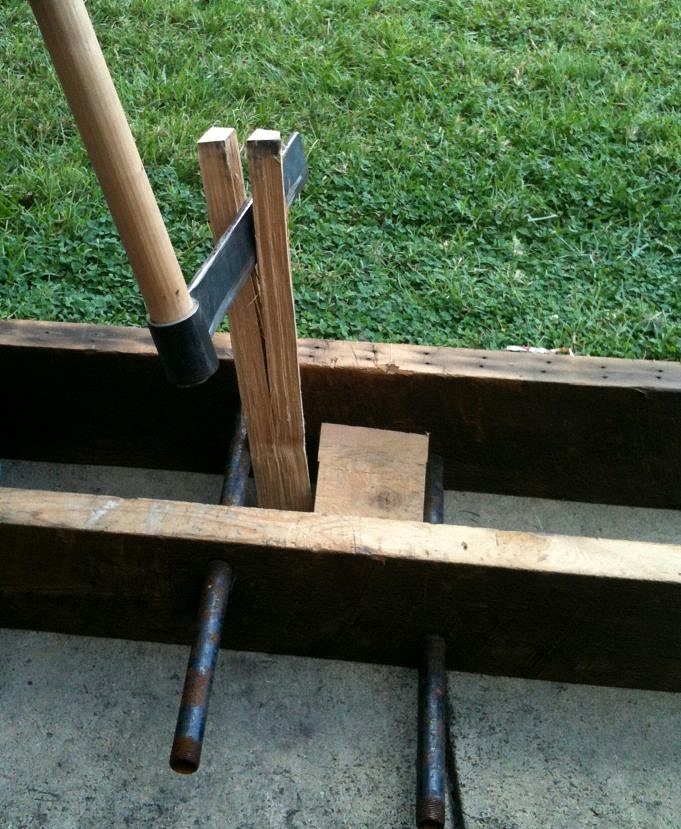Sophisticated. This tripod riving brake is the more sophisticated version of a device that holds logs and billets while they are split with a froe.
Get some splitting leverage with this simple contraption.
Reach for a froe, and you should immediately think, Give me a brake. The brake can be a constructed workholding device, or just a couple of logs. The brake’s purpose is to hold your workpiece so that you can use leverage to split a section of log. To split a piece of wood when it is in a brake, the froe must be used with care. The brake makes this possible.
There are many kinds and configurations of brakes. The first one I learned is just a forked section of a tree, propped up with crossed timbers underneath.
Forked. A student is using a forked tree brake while he rives oak and uses a froe.
Jam your billet into the fork with its other end on the ground, and drive the froe into the top end. Twist the handle of the froe to pull against the thicker end of the split. You might have to flip your workpiece to reach the thicker side depending on how you feel.
In a pinch, I have improvised a brake with a log and a section of split oak; its a bit awkward, but it works. Both cases show that the workpiece is almost vertical.
In a pinch. A log and a split section of wood can serve as a brake if need be.
Many years ago, I learned of a different brake: a large tripod with two cross bars fixed to its two front legs. The latest version, shown at the top of the article, is approximately 6-high and bolted together at its top. The legs are softwood 4x4s; the crossbars are oak 2x6s. The rear leg swings out between the two front legs.
Across the front legs I have variously nailed or lag-bolted two crosspieces. One is horizontal, about waist high. The other is above this rail, angled upward toward the left-hand end of things. The idea is that these two rails create a tapered fork into which you can jam your riving stock.
Another feature is that this upper rail is attached to the front face of my right-hand piece, and behind the other leg. This provides a broader range of points at which to pinch a workpiece. I often add another rail running from the left-hand front leg to the back leg, as shown above. This one is used to grab long, whippy pieces between this side rail’s front lower rail.
I prefer this contraption to a forked-tree riving brake because it puts the workpiece youre riving parallel to the ground. The pressure you apply to control the split is directed downward and not upward like the log brake.
My joiners work is quite simple. All that stock is thick, at least 3 cm to 1.
Oak Hurdles
Recently I was making some garden hurdles, and for those the stuff I want to rive is often quite thin, sometimes only thick. You can easily split lengths up 6 with some practice and good stock.
Oak hurdle. Heres my a hurdle a traditional portable fence based on an English regional style (youve likely also seen woven willow hurdles). The purpose of the fence is the same regardless of the design: keep things in and out.
Having the front rails in different planes helps when coercing a split that threatens to go astray. Because of the offset between the rails, the pressure points have been spread out. Stock rests on the lower bar close to you but is now pinched under the bar about 10-15 cm further back.
This is helpful when youre directing the froes action by leaning on the heavier side of the split. If the stock is sagging, you can bend it and force it back on track. Longer stock achieves the same by being trapped on top of the front lower rail and under the side rail.
The action of riving long stock is more gentle than a quick jerk of froe. Instead, it involves a gentle levering of the handle. The sound isn’t the splitting of fibers with wedges but rather a tic-tic tic as each push on your handle moves the split forward a bit.
Watch as you go, if the split runs out toward a thinner side, flip the stock over so the thick half of the split is down, and lean on the top as you push the now-thicker side down. You’ll be back on track by pressing the handle tic-tic tic. Easy does it.
Three uprights, several rails, and a few braces are the hurdles. To make mortises, bore holes in the uprights and use a chisel. Hew or use a drawknife to fit the rails. All the joints and the braces are nailed or pegged in place.
Bore Lay out your mortise locations, and bore a hole at either end.
then Chop. Use a chisel to chop out the waste between the holes.
Keep your hurdles light; these originally served as portable enclosures for sheep. My yard is not home to any sheep, so I use hurdles to prevent my kids from falling into the river during winter sledding. PWM
Rails. Use a hatchet or drawknife to shape the rails and fit the through-tenons (which neednt be tight), then peg or nail the braces in place.
Peter has been involved in traditional craft since 1980. Read his blog at pfollansbee.wordpress.com.
This article appeared first in the April 2016 issue. Purchase this issue.
This issue’s article index is available.
Recommendations for Product
These are the tools and supplies we use every day in the shop. We may receive a commission from sales referred by our links; however, we have carefully selected these products for their usefulness and quality.



